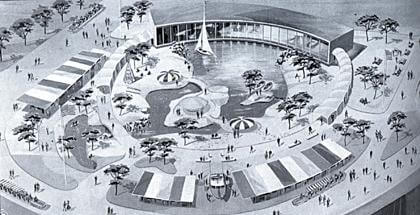By Jeremy Walsh
Many people remember the 1964-65 World's Fair in Flushing Meadows Corona Park as a triumphant showcase of modern thinking and design. But for two authors, the fair was just as compelling for its incomplete dreams, evolution over two seasons and eventual disassembly.
“The 1964-65 New York World's Fair: Creation and Legacy” by Bill Cotter and Bill Young offers a photographic account of the way the fair emerged from the park and then faded away after the summer of 1965.
Cotter and Young had already written a book about the World's Fair in 1994. This time, Cotter said, the intention was to explore more about how the fair came to be, what it took to build it and what it left behind.
One of Cotter's favorite subjects are the pavilions that were planned but never built.
“One was going to be built for the western mountain states,” he said. “It was going to be bigger than the Matterhorn at Disneyland. Outside there would be people climbing it, but inside there would be a giant amphitheater and around that would be booths so that people from Colorado, New Mexico could talk about their states. Like many ambitious projects, it just ran out of money.”
For Cotter, who went on to become a communications engineer for Disney, the World's Fair was a formative experience. At age 12, he was living on Long Island and had just enough money and friends working at the fair to go on a regular basis.
“A number of years later, I went out to Disney World and just walked through the gates and fell in love with the place,” he said. “It was just like having 1964 come flooding back again.”
Of course, undertaking a book about the World's Fair requires similar experiences, and Cotter, a self-proclaimed pack rat, has an entire garage full of World's Fair artifacts and memorabilia.
“I started saving all sorts of stuff back in the '60s — brochures, magazines, handouts, anything I could get,” he said. “Then, after we moved out to California, I'd start frequenting auction catalogs, mailers from dealers. Then, when the Internet came along, that was the eye-opener as to how much you could empty your bank account and fill up your garage.”
He estimates 90 percent of the images used in the new book are his. The rest came from other collectors and family members of people who helped build the pavilions at the fair.
Cotter thinks the world may have moved beyond the World's Fair model as bigger theme parks have provided the spectacle in people's lives and cheaper air travel allowed them to see more of the world firsthand.
“When I was 12, I don't think I'd ever been further than Pennsylvania,” he said. “I don't think I thought I'd ever be walking down the street in Berlin, so talking to German people was exciting.”
But the legacy of the fair, including many architectural pieces, lives on.
“There's pieces of it everywhere,” Cotter said. “That's kind of a fun kick, that you can still go around and see parts of it scattered across the country.”
The Austria pavilion became a ski lodge in northern California. A Ferris wheel designed to look like a giant Uniroyal tire was transported to the outskirts of the rubber company's sales office in Michigan. And an intricate stained-glass window that stood in the Protestant and Orthodox Center was taken afterward to a church in Granada Hills, Calif., where Cotter now lives.
“I had been driving for 30 years past that window and never knew it was there,” he said.
Reach reporter Jeremy Walsh by e-mail at jwalsh@timesledger.com or by phone at 718-229-0300, Ext. 154.


































